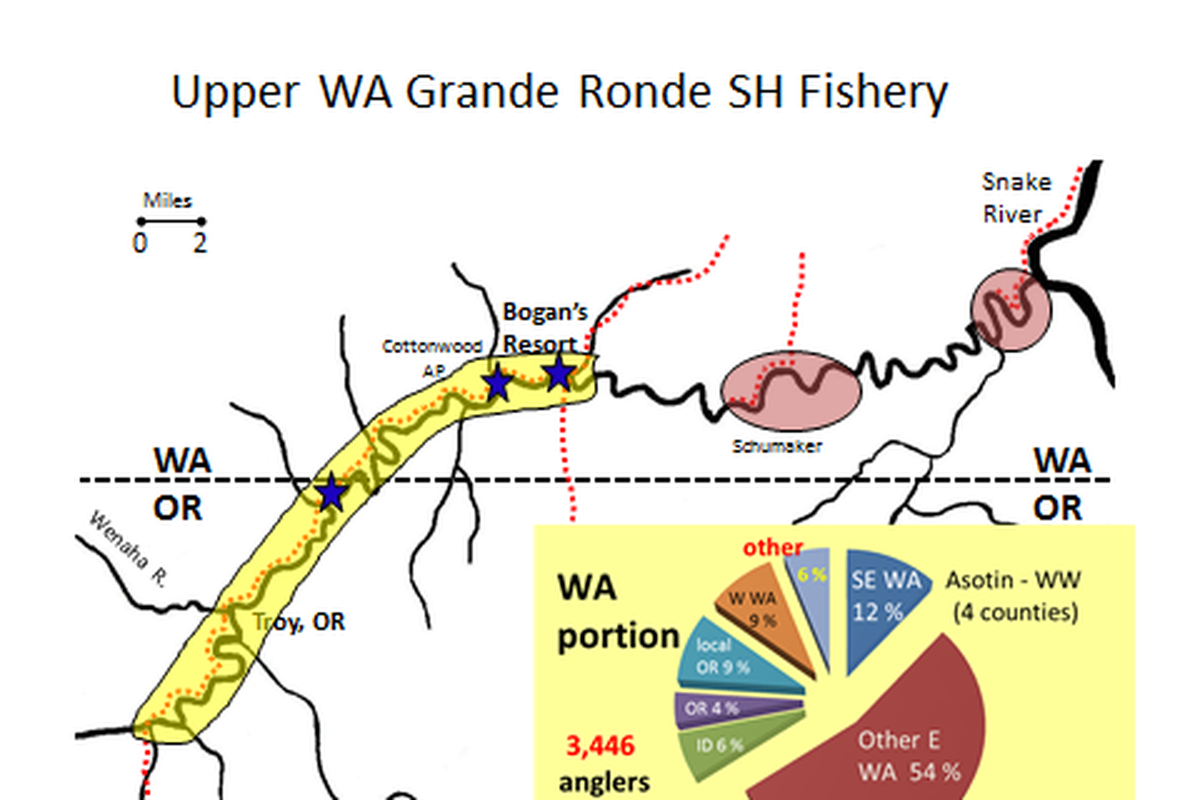Biologist opposes detail in catch-and-release proposals for Grande Ronde steelhead

FISHING -- Comment are due on Dec. 1 for a proposed a rule that would require anglers to keep all hatchery steelhead they catch on most of southeastern Washington, including the Grande Ronde with the exception of the first 2.5 miles up from the mouth.
See story here for the explanation of why the state is seeking the rule change.
To say the least, the proposal is causing a lot of discussion among anglers:
- Catch-and-release enthusiasts would see good fishing days shortened if they had to stop after the second or third hatchery fish was taken into possession as required.
- Wild steelhead advocates say anglers should participate in the effort to keep hatchery steelhead from fouling the spawning areas of wild steelhead.
Check out this and other proposals and make comments online.
Zero in the the stream strategy proposals here. Look under Asotin, Columbia, Garfield, Walla Walla, and Whitman counties.
Some anglers are confused as to why the proposed rule would be more lenient on catch-and-release fishing in the 2.5 miles of the Grande Ronde up from its mouth to the county bridge.
Glen Mendel, a recently retired Washington Department of Fish and Wildlife fisheries biologist who devoted much of his career to steelhead in southeastern Washington waters, supports catch and release in the lower section of the Grande Ronde but opposes the rule as proposed.
He says he supports continuing catch-and-release in the lower Grande Ronde. "I am recommending against harvest in the lower 2.5 miles," he said.
To help anglers understand what's at stake, he put together the following explanation of his thoughts on the proposal. Read them ALL THE WAY TO THE END.
(Slide through the images above to see the graphics to which he refers in his text.)
As the recently retired fish management biologist for SE WA, I would like to provide some perspective regarding the current steelhead regulations in the lower 2.5 miles of the Grande Ronde River, as well as explain why I don’t think the regulations should change there to allow retention of steelhead.
In the 1970s, steelhead returns to SE WA were very poor and restrictions (including closures) were put in place in an effort to protect wild steelhead populations. Public meetings occurred regarding steelhead regulations and fishery options for the Grande Ronde River within Washington. Anglers were in disagreement, with some anglers wanting only catch and release fisheries and others wanting harvest opportunities. These meetings were apparently contentious. The lower 2 ½ miles set up as a catch and release fishery for steelhead as early as 1975, and later in the mid 1980s the remainder of the river was opened to provide opportunities to harvest returning hatchery steelhead produced as part of the Lower Snake River Compensation program in WA and OR. Suggestions regarding changing the steelhead fishing regulations in the Grande Ronde have continued to come in nearly every year by various fishing interests that propose either allowing harvest throughout the entire Grande Ronde River within WA, or changing it all to catch and release and/ or fly fishing only.
The current fishing opportunities have proven to be popular and the Grande Ronde steelhead fisheries in southeast Washington (SE WA) attract anglers from all over the northwest and the nation (see figs. 1, and 2 from WDFW for anglers interviewed in both the upper portion of the Grande Ronde River in WA, and Fig. 3 from the lower 2 ½ miles). These fisheries are nationally renowned and promoted in most regional and national fishing magazines. Anglers are known to stay to fish the Grande Ronde for 3-30 consecutive days. Therefore, it should be obvious that the Grande Ronde steelhead fisheries provide substantial contributions to the state and local economies.
Many anglers are attracted to the relatively unique steelhead fishing opportunities in the lower 2 ½ miles of the Grande Ronde River (from the mouth to the County Road Bridge), plus many (~39% in 2013) of those anglers have extended fishing trips of 7 days or longer in this area (Figure 3). This lower river section is bordered on both sides by easy road and river access, plus it is relatively close to population centers at Lewiston, ID, and Asotin and Clarkston, WA. This area is also adjacent to fishery areas on the Snake River and upper portions of the Grande Ronde (within WA and OR) that allow harvest opportunities and provide other steelhead fishery options (e.g. use of drift boats on both rivers, and power boats on the Snake River) that are not available in the lower zone of the Grande Ronde. Quality steelhead fishing exists on the lower 2 ½ miles of the Grande Ronde River during September through early November, with some anglers having reported catching as many as 10-20 steelhead in a single day there. Few holes and preferred fishing areas exist in this 2 ½ miles and fishing can be crowded at times during the peak fall months. This zone provides a highly valued, quality, fishing experience for steelhead anglers because of its lower river location where fish tend to stack up, its close proximity to other adjacent fishing areas with different fishing opportunities, and its regulations that require selective gear catch and release fishing. The proposed change to the regulations and the fishery in this zone of the Grande Ronde River is not necessary to allow harvest or to try to maintain consistency of the mandatory hatchery steelhead retention requirement because the fishing regulations in this 2 ½ mile zone of the Grande Ronde will not make, break, or substantially contribute to, recovery or restoration of wild steelhead populations as it comprises less than 1% of all the river miles open for steelhead fishing within SE WA (including the Snake, Grande Ronde, Tucannon, Touchet and Walla Walla rivers).However, current regulations do provide a highly valued and unique steelhead fishing opportunity in SE WA. This area should continue to be managed as it is under current regulations to provide a quality fishery and to provide different fishery experiences within about a 5-10 mile radius of the mouth of the Grande Ronde. It is not uncommon for Fish and Wildlife agencies to attempt to provide different types of hunting or fishing opportunities for the public by changing the timing and area of open seasons, as well as adjusting the gear type or harvest regulations to address the desires of different hunting or fishing publics. Not all these types of changes are intended as conservation actions.
As examples of efforts to create different opportunities, different hunting seasons and regulations (e.g. archery, muzzleloader and modern firearm) are offered to meet different management objectives and public hunting preferences in WA, plus about 35 miles away from the lower Grande Ronde the Idaho Department of Fish and Game provides catch and release steelhead fisheries each year in the lower Clearwater River until October 15 in order to maintain a highly valued, and relatively unique, fishing experience prior to opening that area for crowds and harvest.
I strongly recommend that WDFW reconsider the proposed change and maintain the current steelhead regulations and the catch and release steelhead fishery in the lower Grande Ronde River. I see no need to change the current regulations for that lower zone.I am very concerned that allowing harvest in this 2 ½ mile zone, with its easy access on both sides of the river, limited number of preferred fishing areas available, and the very large crowds of anglers that take up residence during the fall months in adjacent areas at Heller Bar (as well as within a 30 minute to 4 hour drive) would likely destroy this great fishery and a great combination of adjacent fishing opportunities that currently satisfy differing recreational fisheries.
This area is likely to become very crowded under the proposed harvest option and it may increase the frequency of angler disputes there.
I recommend maintaining the current very high quality, and highly valued, catch and release fishery in the lower 2 ½ miles of the Grande Ronde River, at least during the three primary fall fishing months of September, October and November.
